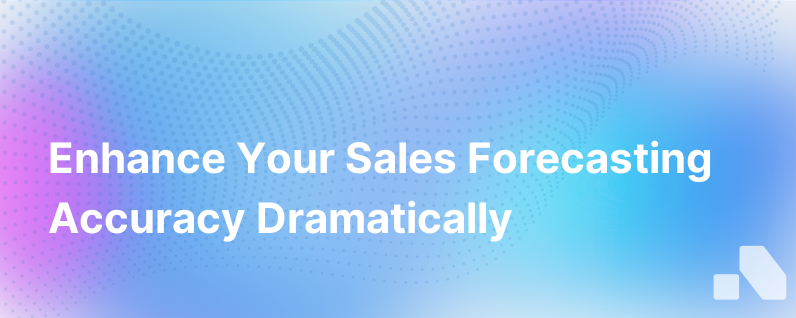
In the complex dance of business growth, sales forecasting stands out as the choreography that aligns all moves. It is the instrument by which companies can synchronize their planning, allocation of resources, and market expectations. When dance moves are out of sync, you may face stock-outs, cash flow issues, or missed opportunities. Sales forecasting, when accurate, can prevent these missteps.
Yet, for many organizations, the accuracy of sales forecasting often feels like hitting the bullseye in a bout of blindfolded archery. Improving the precision of sales forecasts is paramount for the financial health and operational efficiency of any company.
Herein, we will navigate the essence of sales forecasting accuracy, its impact on businesses, and the strategies and tools that can optimize its effectiveness.
Understanding Sales Forecasting Accuracy
Sales forecasting is the process of estimating future sales. Accuracy in this context means the closeness of the forecast to the actual sales results. Improving forecast accuracy is a blend of art and science - requiring both qualitative insights from sales professionals and data-driven analytics.
Why is Sales Forecasting Accuracy Important?
Accurate sales forecasts are critical for a multitude of reasons. They serve as a compass for strategic planning, a blueprint for budgeting, and a gauge for company performance and health. Here are a few reasons why sales forecasting accuracy should be a top priority:
- Resource Allocation: With accurate forecasts, a business can optimize its resource allocation, ensuring that it has the necessary inventory, staffing, and capital expenditures to meet anticipated demand without over-committing resources.
- Cash Flow Management: Precise sales predictions enable better cash flow management. Understanding future revenue streams influences investment strategies and financial planning.
- Strategic Initiatives: Sales forecasting helps to schedule launches, marketing campaigns, and expansion plans. Inaccurate forecasts can domino into strategic failures, while clearing the fog off future sales ensures well-timed initiatives.
- Investor Relations: Investors expect realistic projections. Accurate forecasts can boost investor confidence and facilitate fundraising efforts.
- Risk Mitigation: Forecasting helps identify market trends and potential risks, allowing companies to adjust strategies proactively rather than reacting when it's too late.
Challenges in Achieving Sales Forecasting Accuracy
Multiple factors contribute to the difficulty of achieving accurate sales forecasts:
- Market Volatility: Changes in consumer preferences, economic downturns, or global events can cause sudden market shifts, making historical data less reliable as a forecasting benchmark.
- Sales Complexity: Long sales cycles, particularly in B2B settings, can involve numerous stakeholders and decision-makers, each adding variability to the forecast.
- Data Quality: Poor data quality can severely impact the accuracy. Inconsistencies, incomplete CRM entries, and outdated information can skew the picture.
- Human Bias: Sales personnel may either be overly optimistic or conservative in their projections, influenced by subjective experiences rather than objective analysis.
Best Practices in Improving Sales Forecasting Accuracy
Here are some strategies to enhance the precision of your sales forecasting efforts:
Embrace Technology
Modern sales platforms, such as CRMs, harness AI and machine learning to analyze vast amounts of data, detect patterns, and offer predictive insights. These insights reduce the reliance on gut feelings and biased presumptions.
Leverage Data Analytics
Consistently collecting and reviewing sales data, while employing statistical methods, can yield a more nuanced understanding of sales trends and lead to more accurate forecasts.
Continuous Training
Upskilling your sales team in the effective use of analytics tools helps merge the human and machine aspects of forecasting. Predictive selling skills should be cultivated so that sales teams can interpret data-driven insights effectively.
Sales and Marketing Alignment
Maintaining a close alignment between sales and marketing ensures consistent messaging and better qualification of leads, which can directly impact the predictability of future sales.
Real-time Insights
Maintaining a real-time overview of the sales funnel through an integrated sales platform allows for rapid adjustments to the forecast in response to emerging data, ensuring agility in the forecasting process.
Scenario Planning
Preparing multiple forecasts based on different scenarios can help companies navigate uncertainty and react to changes in real-time.
Regular Review and Feedback Loops
Frequent reassessment and updating of forecasts in light of new information, as well as post-mortem analysis to understand variances, improve forecast mechanisms over time.
Focus on Forecastable Elements
Concentrate efforts on forecasting elements with consistent historical patterns and more predictable outcomes.
Sales Forecasting and AI: A Symbiosis for Accuracy
In the current digital era, Artificial Intelligence (AI) has become a linchpin in achieving accurate sales forecasts. AI platforms sift through myriad data points - from market trends to sales interactions - to unearth factors that truly impact sales outcomes.
Let's look at how an AI platform, such as Aomni, is revolutionizing the accuracy of sales forecasting:
Automated Data Mining
Aomni's AI capabilities automate the labor-intensive process of data collection and analysis, providing your team with precise, real-time insights on sales trends and customer behaviors.
Pattern Recognition
Machine learning algorithms can identify patterns invisible to the human eye, enhancing the predictive quality of the sales forecast.
Bias Elimination
By relying on data-driven predictions, AI helps to remove human bias, leading to more balanced and objective forecasts.
Continuous Learning
AI platforms evolve with every new piece of data, meaning forecasting models become more refined and accurate over time.
In the end, sales forecasting accuracy is not solely about numbers; it's about the veracity, dependability, and actionability of those numbers to drive a business's strategic operations forward. By integrating disciplined sales processes, alignment across organizational functions, and leveraging the latest in AI-driven analytics, companies can dance to a rhythm that resonates with the pulse of the market.
Companies like Aomni offer AI-driven platforms that can be a valuable ally in this quest for forecasting precision. By automating the data analysis process and providing real-time, actionable insights, Aomni helps businesses move beyond guesswork, bringing a new level of sophistication to the art and science of sales forecasting.